The new Salem Chapel was funded largely by a loan from Samuel (later Sir Samuel) Morton Peto. A Baptist himself, Peto was one of the great railway contractors of the Victorian age, responsible for laying around 750 miles of track in England and more than 2,300 miles globally. Peto’s company also built Nelson’s Column, in London. The man himself served as an MP for more than 20 years, resigning his seat in 1866, having been declared technically insolvent, although he was owed more than £1 million in unpaid debts.
A plaque on display in the pub, in memory of Rev. William Sampson.
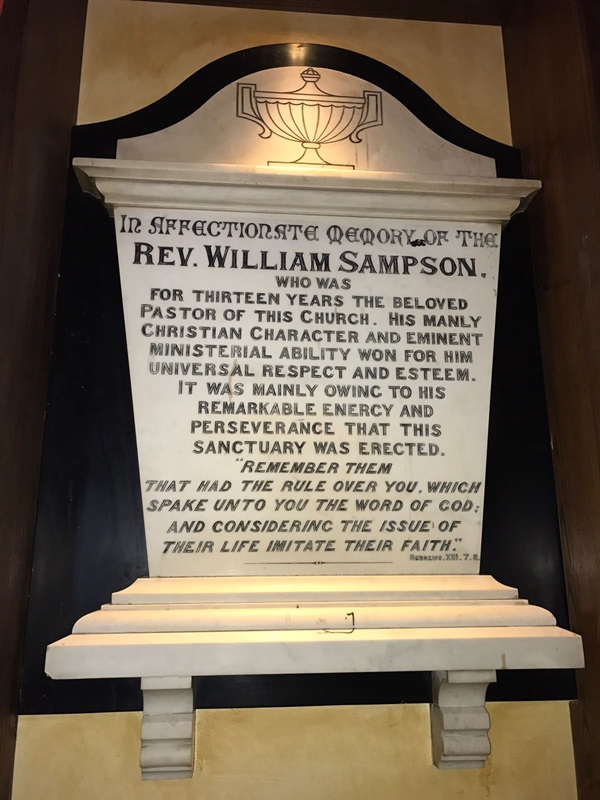
The plaque reads: In affectionate memory of the Rev. William Sampson.
Who was for thirteen years the beloved pastor of this church. His manly Christian character and eminent ministerial ability won for him universal respect and esteem. It was mainly owing to his remarkable energy and perseverance that this sanctuary was erected.
“Remember them that had the rule over you, which spake unto you the word of God: and considering the issue of their life imitate their faith.” Hebrews XIII 7.8.
A similar plaque, in memory of Mr William Harvey Stace.
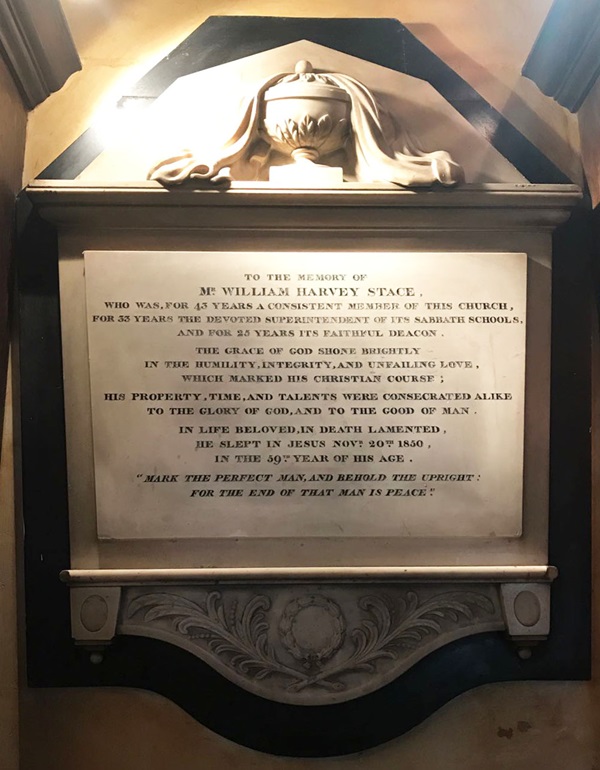
The plaque reads: To the memory of Mr William Harvey Stace, who was for 43 years a consistent member of this church, for 33 years the devoted superintendent of its Sabbath schools, and for 25 years its faithful deacon.
The grace of God shone brightly in the humility, integrity, and unfailing love, which marked his Christian course; his property, time, and talents were consecrated alike to the glory of God, and to the good of man.
In life beloved, in death lamented, he slept in Jesus Nov 20 1850, in the 59th year of his age.
“Mark the perfect man, and behold the upright: for the end of that man is peace”.
A photograph and text about the Pleasure Gardens.

The text reads: The Pleasure Gardens evolved from a grand scheme of the Folkestone Art Treasures Exhibition Company, which was formed in 1886.The company’s aims were to exhibit the best in painting and sculpture. A large exhibition hall was built with a glass roof and spacious galleries, rather like The Crystal Palace.
To attract visitors from neighbouring towns, a special railway was built from Shorncliffe Station to the building which was set in extensive ornamental grounds. However, it was not widely supported and closed after just five months.
Two years later the site was sold to the Folkestone Exhibition Palace Company and soon afterwards the name was changed to the Pleasure Gardens Company. Within the sixteen acre grounds, there were facilities for tennis, hockey, croquet, and skating, and there was a bandstand. Military displays and tournaments were held and proved to be a popular attraction. The Exhibition Palace Theatre opened in 1888, later called the Pleasure Gardens Theatre. For many years it presented a weekly programme of plays, opera, Shakespearean productions, romantic comedies, reviews and musicals. In its hey-day it was a great asset to the town.
Top: Interior of the Art Treasures Exhibition, 1886
Above: Art Treasures Building, later the Pleasure Gardens Theatre.
Prints and text about Charles Dickens.
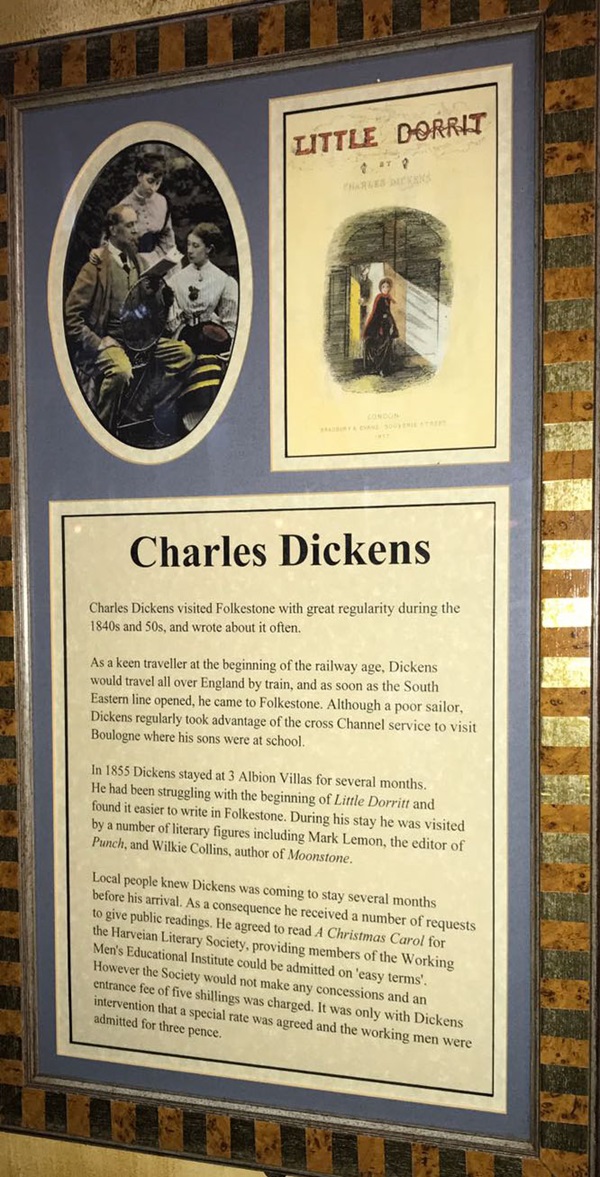
The text reads: Charles Dickens visited Folkestone with great regularity during the 1840s and 50s, and wrote about it often.
As a keen traveller at the beginning of the railway age, Dickens would travel all over England by train, and as soon as the South Eastern line opened, he came to Folkestone. Although a poor sailor, Dickens regularly took advantage of the cross Channel service to visit Boulogne where his sons were at school.
In 1855 Dickens stayed at 3 Albion Villas for several months. He had been struggling with the beginning of Little Dorritt and found it easier to write in Folkestone. During his stay he was visited by a number of literacy figures including Mark Lemon, the editor of Punch, and Wilkie Collins, author of Moonstone.
Local people knew Dickens was coming to stay several months before his arrival. As a consequence he received a number of requests to give public readings. He agreed to read A Christmas Carol for the Harveian Literary Society, providing members of the Working Men’s Educational Institute could be admitted on easy terms. However the society would not make and concession and an entrance fee of five shillings was charged. It was only with Dickens intervention that a special rate was agreed and the working men were admitted for three pence.
A print and text about HG Wells.

The text reads: The author of HG Wells lived at Sandgate on the coast to the west of Folkestone. He moved there to recuperate following a painful illness, and decided to stay. Wells had Spade House built with royalties from novels like First Men in the Moon and The War of The Worlds.
Whilst at Spade House he wrote three of his most important novels – Kipps, which is set in Folkestone, The History of Mr Polly and Tono Bungay. They were written in what is now a tool shed, and Wells would start as early as 4am to escape from his two young sons.
He lived at Sandgate between 1890 and 1910 and throughout his stay many of the leading literacy figures of the time came to visit. Among them, Sir James Barrie, the creator of Peter Pan, the authors GK Chesterton, Henry James and George Bernard Shaw.
Whilst at Sandgate, Wells enjoyed a brief period of respectability as a Borough Magistrate. He attended “boring lunches” at Sir Edward Sassoon’s house, where he met the young Winston Churchill.
Above: HG Wells with his mother Sarah, outside the house Charles Voysey Built for him near Folkestone.
Text about the Baptist Chapel.
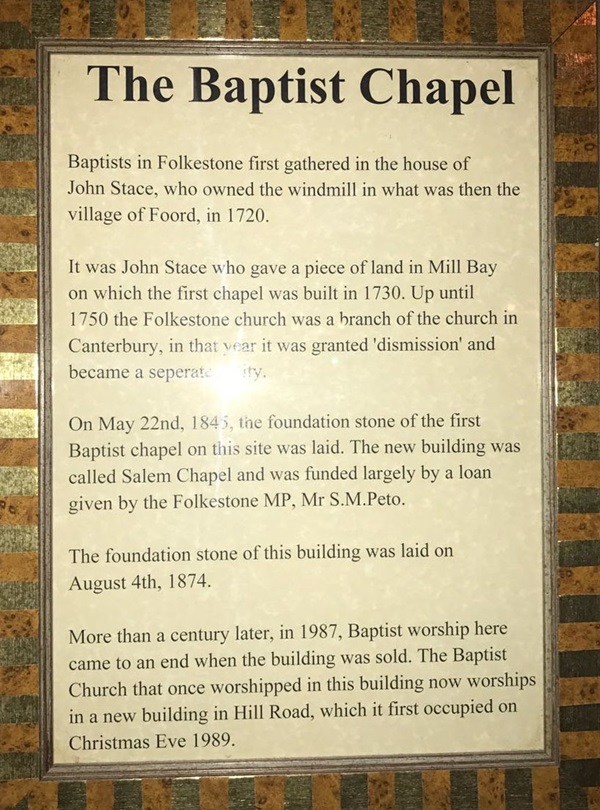
The text reads: Baptists in Folkestone first gathered in the house of John Stace, who owned the windmill in what was then the village of Foord, in 1720.
It was John Stace who gave a piece of land in Mill Bay on which the first chapel was built in 1730. Up until 1750 the Folkestone church was a branch of the church in Canterbury, in that year it was granted ‘dismission’ and became a separate entity.
On May 22 1845, the foundation stone of the first Baptist chapel, on this site was laid. The new building was called Salem Chapel and was funded largely by a loan given by the Folkestone MP, Mr SM Peto.
The foundation stone of this building was laid on August 4 1874.
More than a century later, in 1987, Baptist worship here came to an end when the building was sold. The Baptist Church that once worshipped in this building now worships in a new building in Hill Road, which it first occupied on Christmas Eve 1989.
Prints and text about William Cubitt.

The text reads: William Cubitt probably did more to modernise Folkestone and bring prosperity to the town than any other person in the 19th century. He was the chief engineer of the South Eastern Railway Company, and in order to negotiate the difficult terrain around Folkestone, designed a viaduct across the Foord valley. Its 19 arches reach 100 feet above the valley floor, and it was built from millions of locally made bricks.
Following the decision by the railway company to buy Folkestone harbour, Cubitt designed the rail link between the main line and the harbour, as well as the swing bridge, station and the Pavilion Hotel.
Top: The Foord Viaduct, 1865
Above: top, Foord Viaduct, 1844, centre, the south eastern jetty and the first swing bridge, c1850, below, the Royal Pavilion Hotel.
Prints and text about the Guildhall.
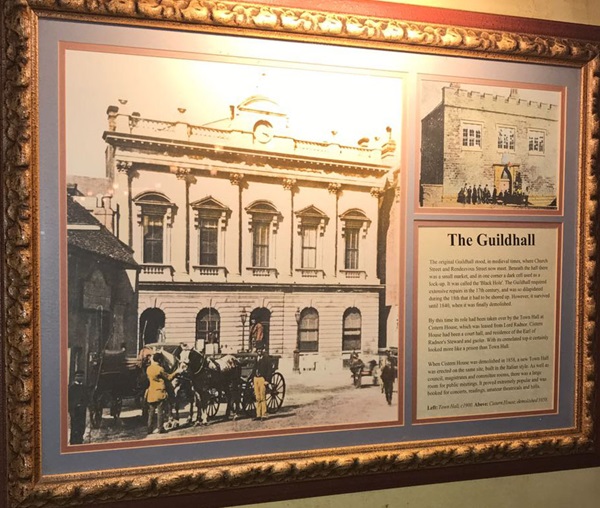
The text reads: The original Guildhall stood, in medieval times, where Church Street and Rendezvous Street now meet. Beneath the hall there was a small market, and in one corner a dark cell used as a lock-up. It was called the ‘Black Hole’. The Guildhall required extensive repairs in the 17th century, and was so dilapidated during the 18th century that it had to be shored up. However, it survived until 1840, when it was finally demolished.
By this time its role had been taken over by the Town Hall at Cistern House, which was leased from Lord Radnor. Cistern House had been a court hall, and residence of the Earl of Radnor’s Steward and gaoler. With its crenelated top it certainly looked more like a prison than Town Hall.
When Cistern House was demolished in 1858, a new Town Hall was erected on the same site, built in the Italian style. As well as council, magistrates and committee rooms, there was a large room for public meetings. It proved extremely popular and was booked for concerts, readings, amateur theatricals and balls.
Left: Town Hall, c1900
Above: Cistern House, demolished 1858.
Prints and text about the Earl of Radnor.
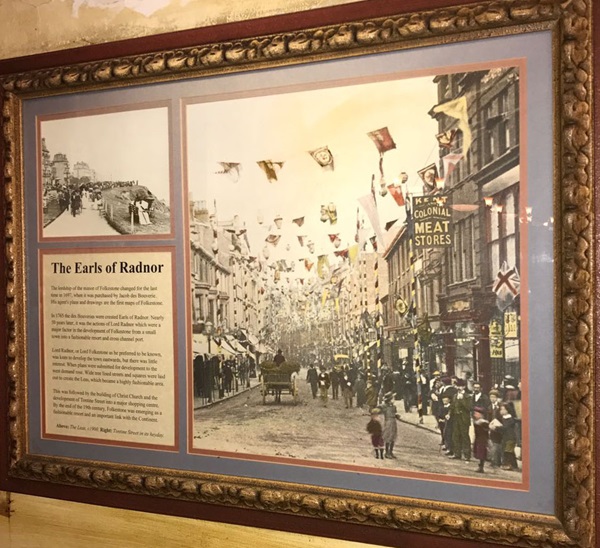
The text reads: The lordship of the manor of Folkestone changed for the last time in 1697, when it was purchased by Jacob des Bouveries. His agent’s plans and drawings are the first maps of Folkestone.
In 1765 the des Bouveries were created Earls of Radnor. Nearly 50 years later, it was the actions of Lord Radnor which were a major factor in the development of Folkestone from a small town into a fashionable resort and cross channel port.
Lord Radnor, or Lord Folkestone as he preferred to be known, was keen to develop the town eastwards, but there was little interest. When plans were submitted for development to the west demand rose. Wide tree lined streets and squares were laid out to create the Leas, which became a highly fashionable area.
This was followed by the building of Christ Church and the development of Tontine Street into a major shopping centre. By the end of the 19th century, Folkestone was emerging as a fashionable resort and an important link with the continent.
Above: The Leas, c1900
Right: Tontine Street in its heyday.
A photograph and a text about Eric Hart.

The text reads: Eric Hart with the Dutch Standaart cinema organ rebuilt in his home;
The former Baptist Church contained a very fine pipe organ, and it was pleasing to see the retention of a façade of these pipes, set in prominence at the far end of the balcony, imposing an air of dignity, although destined for a life of silence.
However, this was not to be the fate of the entire organ, for with the permission of the previous owners, a considerable number of the pipes were recused by Eric Hart and received a new lease of life incorporated into the former cinema organ installed in his home.
The instrument resided in the old Savoy cinema between 1929-63 when it was purchased by Mr Hart. The building still stands just 80 yards away from this pub – although empty and deserted.
Prints and text about Stephen Court.
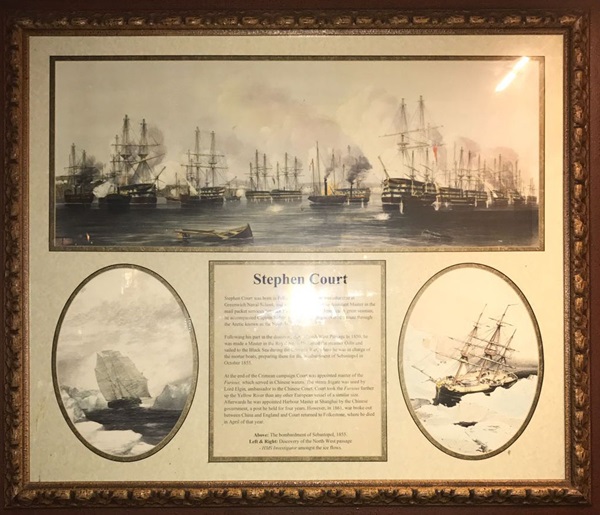
The text reads: Stephen Court was born in Folkestone in 1826. He was educated at Greenwich Naval School, and when he left he became assistant manager in the mail packet services between Falmouth and South America. A great seaman, he accompanied Captain Robert Mclure when he discovered a route through the Arctic known as the North West Passage.
Following his part in the discovery of the North West Passage in 1850, he was made a master in the Royal Navy. He joined the steamer Odin and sailed to the Black Sea during the Crimean War, where he was in charge of the mortar boats, preparing them for the bombardment of Sebastopol in October 1855.
At the end of the Crimean campaign, Court was appointed master of the Furious, which served in Chinese waters. Court took the Furious further up the Yellow River than any other European vessel of a similar size. Afterwards he was appointed harbour master at Shanghai by the Chinese government, a post he held for four years. However, in 1861, war broke out between China and England and Court returned to Folkestone, where he died in April of that year.
Above: The bombardment of Sebastopol, 1855
Left and right: Discovery of the North West passage – HMS Investigator amongst the ice flows.
An illustration and photographs of the Baptist Chapel in Folkestone.
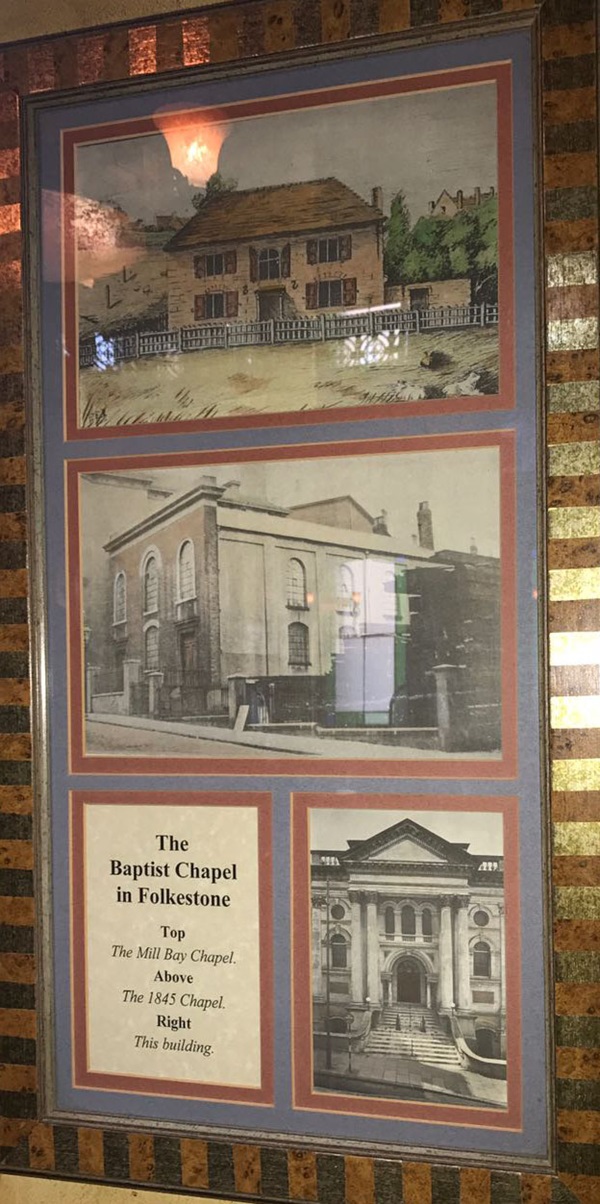
Top: The Mill Bay Chapel
Above: The 1845 chapel
Right: This building.
A photograph of Priory Gardens, Folkestone, c1905.
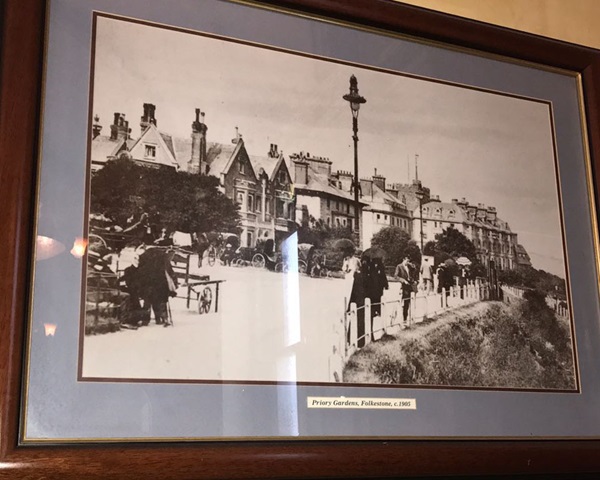
A photograph of The Leas, Folkestone, c1908.

External photograph of the building – main entrance.

If you have information on the history of this pub, then we’d like you to share it with us. Please e-mail all information to: pubhistories@jdwetherspoon.co.uk